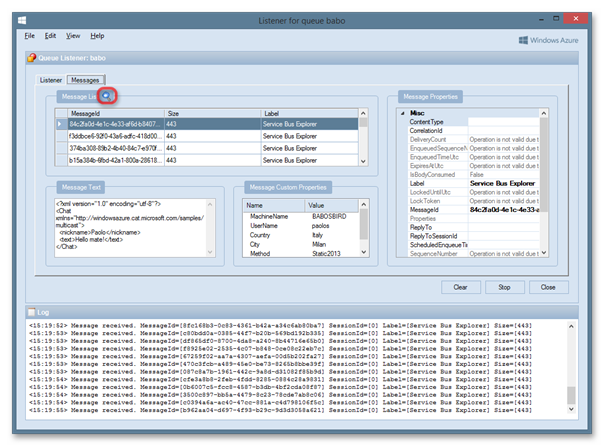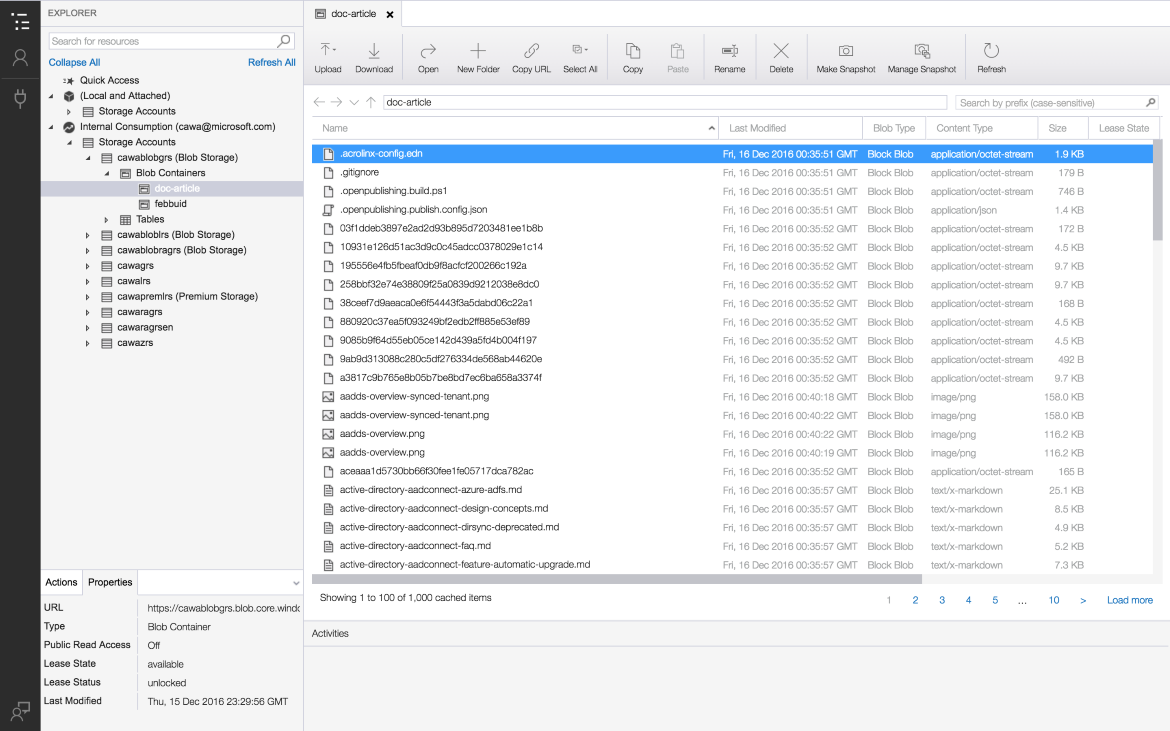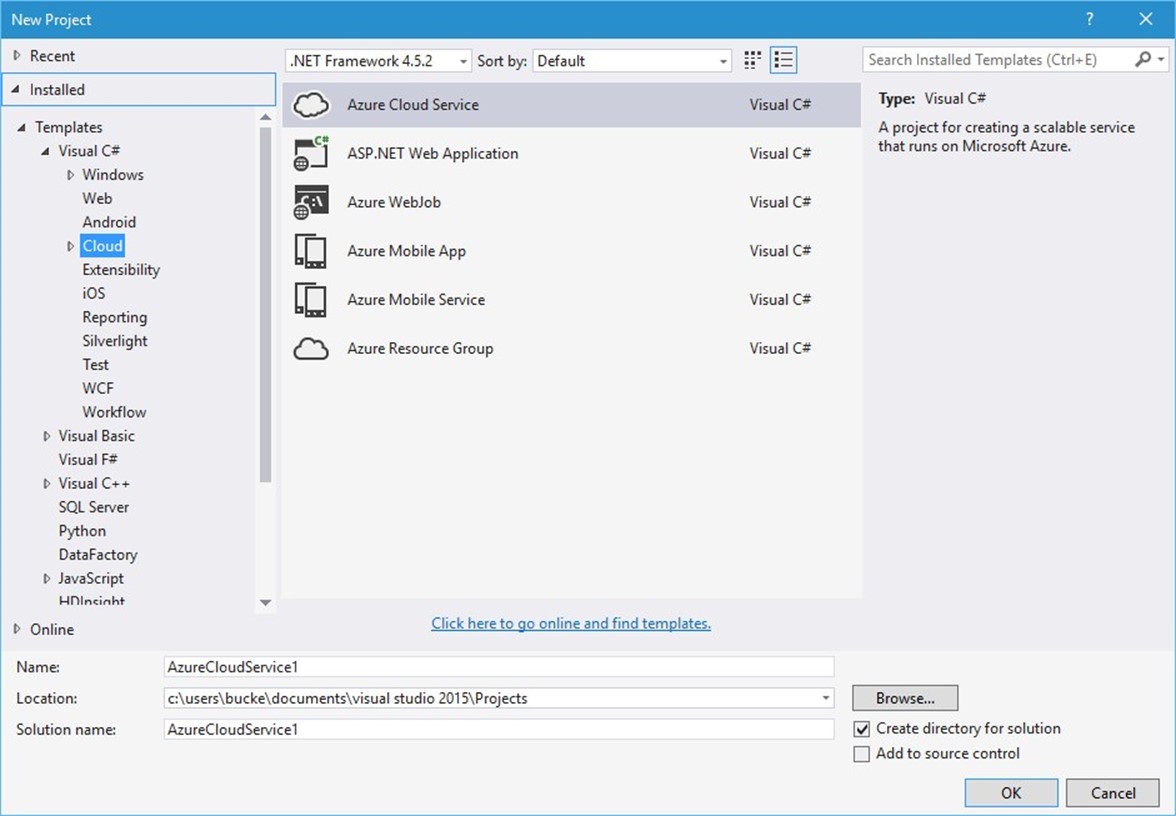Service Bus Explorer Download Mac

Kusto.Explorer is a rich desktop application that enables you to explore your data using the Kusto Query Language in an easy-to-use user interface. This overview explains how to get started with setting up your Kusto.Explorer and explains the user interface you will use.
With Kusto.Explorer, you can:
- Query your data.
- Search your data across tables.
- Visualize your data in a wide variety of graphs.
- Share queries and results by email or using deep links.
Purple Explorer - cross-platform Azure Service Bus explorer (Windows, macOS, Linux) Purple Explorer is a cross-platform desktop application built with.NET Core. It's a simple tool to help you: Connect to Azure Service Bus; View topics and subscriptions; View queues; View active and dead-letter messages; View message body and its details; Send. If you are connecting to Azure Service Bus without using a proxy but have outgoing ports closed in a firewall you need to open additional ports for this release. The ports are 5671 and 5672. If you are connecting to Azure Service Bus through a proxy there is a new setting, Use AmqpwebSockets, which must be enabled in that case.
IBM Software systems and applications are designed to solve the most challenging needs of organizations large and small, across all industries, worldwide. The Service Bus Explorer tool on the Azure portal is now available in preview. Azure Service Bus, like most other PaaS offerings, has two sets of operations that can be performed against it: Management operations like CRUD (create, read, update, and delete) on Service Bus namespaces, queues, topics, subscriptions, and filters. Service Bus Explorer allows users to connect to a Service Bus namespace and administer messaging entities. Installation Launch VS Code Quick Open ( Ctrl+P ), paste the following command, and press enter.
Installing Kusto.Explorer
Download and install the Kusto.Explorer tool from:
- https://aka.ms/ke (CDN location)
- https://aka.ms/ke-mirror (Non-CDN location)
Instead, access your Kusto cluster with your browser at:
https://<your_cluster>.<region>.kusto.windows.net.Replace <your_cluster> and <region> with your Azure Data Explorer cluster name and deployment region.
Using Chrome and Kusto.Explorer
If you use Chrome as your default browser, make sure to install the ClickOnce extension for Chrome:
Overview of the user interface
Service Bus Explorer Download Mac Download
The Kusto.Explorer user interface is designed with a layout based on tabs and panels, similar to that of other Microsoft products:
- Navigate through the tabs on the menu panel to perform various operations
- Manage your connections in the connections panel
- Create scripts to run in the script panel
- View the results of the scripts in the results panel
Menu panel
Kusto.Explorer Menu panel includes the following tabs:
Home tab
The Home tab shows the most recently used functions, divided into sections:
Query section
| Menu | Behavior |
|---|---|
| Mode dropdown |
|
| New Tab | Opens a new tab for querying Kusto |
Share section
| Menu | Behavior |
|---|---|
| Data To Clipboard | Exports Query and data set to a clipboard. If a chart is presented, it exports the chart as bitmap |
| Result To Clipboard | Exports the data set to a clipboard. If a chart is presented, it exports the chart as bitmap |
| Query to Clipboard | Exports the Query to a clipboard |
Visualizations section
| Menu | Behavior |
|---|---|
| Area chart | Displays an area chart in which the X-axis is the first column (must be numeric). All numeric columns are mapped to different series (Y-axis) |
| Column Chart | Displays a column chart where all numeric columns are mapped to different series (Y-axis). The text column before numeric is the X-axis (can be controlled in the UI) |
| Bar Chart | Displays a bar chart where all numeric columns are mapped to different series (X-axis). The text column before numeric is the Y-axis (can be controlled in the UI) |
| Stacked Area chart | Displays a stacked area chart in which the X-axis is the first column (must be numeric). All numeric columns are mapped to different series (Y-axis) |
| Timeline Chart | Displays a time chart in which the X-axis is the first column (must be datetime). All numeric columns are mapped to different series (Y-axis). |
| Line Chart | Displays a line chart in which the X-axis is the first column (must be numeric). All numeric columns are mapped to different series (Y-axis). |
| Anomaly Chart | Similar to timechart, but finds anomalies in time series data, using the machine learning anomalies algorithm. For anomaly detection, Kusto.Explorer uses the series_decompose_anomalies function. |
| Pie Chart | Displays a pie chart in which the color-axis is the first column. The theta-axis (must be a measure, converted to percent) is the second column. |
| Time Ladder | Displays a ladder chart in which the X-axis is the last two columns (must be datetime). The Y-axis is a composite of the other columns. |
| Scatter Chart | Displays a point graph in which the X-axis is the first column (must be numeric). All numeric columns are mapped to different series (Y-axis). |
| Pivot Chart | Displays a pivot table and pivot chart that gives the full flexibility of selecting data, columns, rows, and various chart types. |
| Time Pivot | Interactive navigation over the events time-line (pivoting on time axis) |
Note
Anomaly Chart:The algorithm expects timeseries data, which consists of two columns:
- Time in fixed interval buckets
- Numeric value for anomaly detectionTo produce timeseries data in Kusto.Explorer, summarize by the time field and specify the time bucket bin.
View section
| Menu | Behavior |
|---|---|
| Full View Mode | Maximizes the work space by hiding the ribbon menu and Connection Panel. Exit Full View Mode by selecting Home > Full View Mode, or by pressing F11. |
| Hide Empty Columns | Removes empty columns from the data grid |
| Collapse Singular Columns | Collapses columns with singular values |
| Explore Column Values | Shows column values distribution |
| Increase Font | Increases the font size of the query tab and of the results data grid |
| Decrease Font | Decreases the font size of the query tab and of the results data grid |
Note
Data View Settings:
Service Bus Explorer Github
Kusto.Explorer keeps track of what settings are used per unique set of columns. When columns are reordered or removed, the data view is saved and will be reused whenever the data with the same columns is retrieved. To reset the view to its defaults, in the View tab, select Reset View.
File tab
| Menu | Behavior |
|---|---|
| ---------Query Script--------- | |
| New Tab | Opens a new tab window for querying Kusto |
| Open File | Loads data from a *.kql file to the active script panel |
| Save To File | Saves the content of the active script panel to *.kql file |
| Close Tab | Closes the current tab window |
| ---------Save Data--------- | |
| Data To CSV | Exports data to a CSV (comma-separated-values) file |
| Data To JSON | Exports data to a JSON formatted file |
| Data To Excel | Exports data to an XLSX (Excel) file |
| Data To Text | Exports data to a TXT (text) file |
| Data To KQL Script | Exports Query to a script file |
| Data To Results | Exports Query and data to a Results (QRES) file |
| Run Query Into CSV | Runs a query and saves the results to a local CSV file |
| ---------Load Data--------- | |
| From Results | Loads Query and data from a Results (QRES) file |
| ---------Clipboard--------- | |
| Query and Results To Clipboard | Exports Query and data set to a clipboard. If a chart is presented, it exports the chart as a bitmap |
| Result To Clipboard | Exports data set to a clipboard. If a chart is presented, it exports the chart as a bitmap |
| Query to Clipboard | Exports the Query to a clipboard |
| ---------Results--------- | |
| Clear results cache | Clears cached results of previously executed queries |
Connections tab
| Menu | Behavior |
|---|---|
| ---------Groups--------- | |
| Add Group | Adds a new Kusto Server group |
| Rename Group | Renames the existing Kusto Server group |
| Remove Group | Removes the existing Kusto Server group |
| ---------Clusters--------- | |
| Import Connections | Imports connections from a file specifying connections |
| Export Connections | Exports connections to a file |
| Add Connection | Adds a new Kusto Server connection |
| Edit Connection | Opens a dialog for Kusto Server connection properties editing |
| Remove Connection | Removes the existing connection to Kusto Server |
| Refresh | Refreshes properties of a Kusto server connection |
| ---------Security--------- | |
| Inspect Your ADD Principal | Shows currents active user details |
| Sign-out From AAD | Signs-out the current user from the connection to AAD |
| ---------Data Scope--------- | |
| Caching scope |
|
| DateTime Column | Name of column which may be used for time pre-filter |
| Time Filter | Value of time pre-filter |
View tab
| Menu | Behavior |
|---|---|
| ---------Appearance--------- | |
| Full View Mode | Maximizes the work space by hiding the ribbon menu and Connection Panel |
| Increase Font | Increases the font size of the query tab and of the results data grid |
| Decrease Font | Decreases the font size of the query tab and of the results data grid |
| Reset Layout | Resets the layout of the tool's docking controls and windows |
| Rename Document Tab | Rename the selected tab |
| ---------Data View--------- | |
| Reset View | Resets data view settings to its defaults |
| Explore Column Values | Shows column values distribution |
| Focus on Query Statistics | Changes the focus to query statistics instead of query results upon query completion |
| Hide Duplicates | Toggles removal of the duplicate rows from the query results |
| Hide Empty Columns | Toggles removal of empty columns from the query results |
| Collapse Singular Columns | Toggles collapsing columns with singular value |
| ---------Data Filtering--------- | |
| Filter Rows In Search | Toggles the option to show only matching rows in query results search (Ctrl+F) |
| ---------Visualizations--------- | |
| Visualizations | See Visualizations, above. |
Note
Kusto.Explorer keeps track of the settings used per unique set of columns. When columns are reordered or removed, the data view is saved and will be reused whenever the data with the same columns is retrieved. To reset the view to its defaults, in the View tab, select Reset View.
Tools tab
| Menu | Behavior |
|---|---|
| ---------IntelliSense--------- | |
| Enable IntelliSense | Enables and disables IntelliSense on the Script Panel |
| ---------Analyze--------- | |
| Query Analyzer | Launches the Query Analyzer tool |
| Query Checker | Analyzes the current query and outputs a set of applicable improvement recommendations |
| Calculator | Launches the calculator |
| ---------Analytics--------- | |
| Analytical Reports | Opens a dashboard with multiple pre-built reports for data analysis |
| ---------Translate--------- | |
| Query to Power BI | Translates a query to a format suitable for using in Power BI |
| ---------Options--------- | |
| Reset Options | Sets application settings to default values |
| Options | Opens a tool for configuring application settings. Learn more about Kusto.Explorer options. |
Monitoring tab
| Menu | Behavior |
|---|---|
| ---------Monitor--------- | |
| Cluster Diagnostics | Shows a health summary for the Server Group currently selected in Connections Panel |
| Latest data: All tables | Shows a summary of the latest data in all tables of the currently selected database |
| Latest data: Selected table | Shows in the status bar the latest data in the selected table |
Management tab
| Menu | Behavior |
|---|---|
| ---------Authorized Principals--------- | |
| Manage Cluster Authorized Principals | Enables managing a cluster's principals for authorized users |
| Manage Database Authorized Principals | Enables managing a database's principals for authorized users |
| Manage Table Authorized Principals | Enables managing a table's principals for authorized users |
| Manage Function Authorized Principals | Enables managing a function's principals for authorized users |
Help tab
| Menu | Behavior |
|---|---|
| ---------Documentation--------- | |
| Help | Opens a link to the Kusto online documentation |
| What's new | Opens a document that lists all Kusto.Explorer changes |
| Report Issue | Opens a dialog with two options:
|
| Suggest Feature | Opens a link to the Kusto feedback forum |
| Check Updates | Checks if there are updates to your version of Kusto.Explorer |
Connections panel

The Connections pane shows all the configured cluster connections. For each cluster the databases, tables, and attributes (columns)that they store are shown. Select items (which sets an implicit contextfor the search/query in the main panel), or double-click items to copy the name to the search/query panel.
If the actual schema is large (such as a database with hundreds of tables), you can search it by pressing CTRL+F and entering asubstring (case-insensitive) of the entity name you're looking for.
Kusto.Explorer supports controlling the Connection panel from the query window, which is useful for scripts. For example, you can start a script file with a command that instructs Kusto.Explorer to connect to the cluster/database whose data is being queried by the script, by using the following syntax:
Run each line using F5, or similar.
Control the user identity connecting to Kusto.Explorer
The default security model for new connections isAAD-Federated security. Authentication is done through theAzure Active Directory using the default AAD user experience.
If you need finer control over the authentication parameters, you can expand the'Advanced: Connection Strings' edit box and provide a validKusto connection string value.
For example, users with a presence inmultiple AAD tenants sometimes need to use a particular 'projection'of their identities to a specific AAD tenant. Do this byproviding a connection string, such as the one below (replace words IN CAPITALS with specific values):
AAD_TENANT_OF_CLUSTERis a domain name or AAD tenant ID (a GUID) of the AAD tenant in which the cluster is hosted. This is usually the domain name of the organization that owns the cluster, such ascontoso.com.- USER_DOMAIN is the identity of the user invited into that tenant (for example,
user@example.com).
Note
The domain name of the user is not necessarily the same as that of the tenant hosting the cluster.
Keyboard shortcuts
You might find that using keyboard shortcuts enables you to perform operations faster than with the mouse. Take a look at this list of Kusto.Explorer keyboard shortcuts to learn more.

Table row colors
Kusto.Explorer tries to interpret the severity or verbosity level of each row in the results panel and color them accordingly. It does this by matching the distinct values of each column with a set of known patterns ('Warning', 'Error', and so on).
To modify the output color scheme, or turn this behavior off, from the Tools menu, select Options > Results Viewer > Verbosity color scheme.
| Excel color scheme legend | Vivid color scheme legend |
|---|
Next steps
Learn more about working with Kusto.Explorer:
Learn more about Kusto.Explorer tools and utilities: